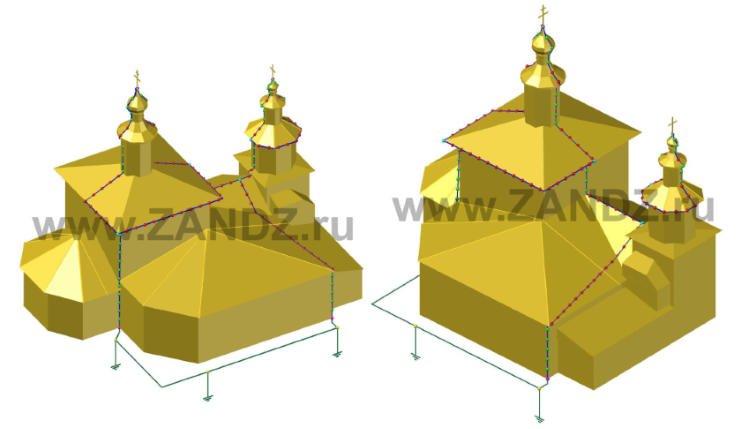A real example of calculating lightning protection for the church is on the separate page.

From the point of view of the organization of lightning protection systems, the above mentioned objects can be referred to the third category of lightning protection systems (see IS 153-34.21.122-2003 "Instructions for lightning protection of buildings, structures and industrial communications" (hereinafter IS) and AD 34.21.122-87 "Instructions for lightning protection of buildings and structures" (hereinafter AD). In this case, the following circumstances should be taken into account:
- almost all religious buildings are considered to be the most complex objects from the architectural and construction point of view;
- as a rule, there are domes, crosses, crescents, weathercocks, statues and other heraldic compositions in these structures, they serve as important elements for the organization of lightning protection systems;
- as a rule, these structures are recognized as objects of historical and artistic value and are protected by the church and the state;
- are cult objects with certain sacred expectations of adherents of certain religious confessions.
Thus, taking into account the above-listed architectural features of these religious buildings, we determine the following distinguishing characteristics of these objects:
- buildings of churches, catholic churches, mosques, etc. were erected and are still erected mostly of brick or stone. In some cases, the method of monolithic construction using prefabricated reinforced concrete is used. Therefore, this characteristic is a big plus in terms of fire hazard;
- The key architectural elements in the organization of lightning protection are metal crosses or other heraldic signs, as well as domes (spires, minarets, etc.) that have a metal frame (less often wooden, impregnated with fire retardant composition) and a sheet steel or copper coating sometimes with gilding. All these elements can be used to receive a direct lightning strike, but only if they meet the regulatory requirements that are indicated below. If the regulations are not followed, separate lightning rods must be used;
- separately, in terms of architecture, it is worth considering, the so-called "wooden church architecture", both ancient and modern. In these buildings, the entire religious structure, including crosses and domes, is constructed of wood, even metal nails are not used. The only metal that is present is the bells. An example of this approach can be a historical and artistic reserve - Kizhi. Of course, such structures are the most fire hazardous, which should be taken into account when organizing lightning protection systems. The only protection option is the installation of lightning rods, for example, rods above the crosses, which will protect the entire structure, together with the wooden crosses.

Recently, "modern" solutions for the manufacture of crosses and domes began to appear more and more often, namely made of fiberglass or other composites based on reinforced carbon with the further deposition of titanium nitride ("fake-gold-look"). Such structures are considered non-conductive, and the organization of the lightning protection part of lightning protection is solved either at the stage of manufacturing structural elements, or by building external (including stand-alone) lightning-rod system, as in the case of wooden structures.
How to make lightning protection of churches and temples
Solution for a lightning detector
The use of the cross, the crescent and the symbols of other religious denominations on the temple spire as a lightning rod is possible if:
- the cult object is conductive or made of metal;
- it matches (GOST R IEC 62561.2-2014) the following conditions, namely: steel is used (thickness of the steel wall is 2.5 mm and the total cross-section is from 50 mm2). In the application of stainless steel products-wall thickness is 2 mm, cross- section is 50 mm2.
In order to properly design an external lightning protection system, the specialists make down conductors from crosses (or from metal structures supporting them) to a grounding device.
In addition, in accordance with the standards of IS and AD, it is necessary to determine the protection zones from possible lightning strikes to check whether the volume of the structure is completely protected by such a natural lightning rod. In case of insufficient protection zone, the issue of additional installation of air-terminals masts, or, possibly, use of a lightning protection mesh the dome of the temple is solved. Protective zones are defined by the "protective angle" method (see 3.3.2 of the IS). If the temple has multiple domes, each dome should have its own lighting rod. On the level of down conductors, traversal coductors, starting from the zero level, in every 15-20 m unite the lightning rods into a single system of lightning protection.
Other parts of the cult structure (see 3.2.1.2 IS) can also be used as natural lightning rods, for example, the roof of domes and the roof of the temple, made, as a rule, of metal. This requires compliance with the following factors:
- implementation of long-term electrical continuity (contact) between the roof elements;
- provision of standards for the thickness of the roof metal not burnt by a lightning strike (not less than 4 mm for iron, for other materials even more);
- the permissible minimum thickness of the roof is 0.5 mm, unless there is a direct threat of ignition of the space under the roof and burning of the roof;
- absence of the roof insulation, but at the same time an anti-corrosion coating (thickness not more than 0.5 mm) is permissible.
For wooden churches with conductive crosses and domes, lightning rods are made in the form of a rod construction fixed to the cross with the help of insulating fasteners or staples, less often in the form of separately standing mast lightning protection systems.
Solutions for down conductors
At least two down conductors must go from each lightning rod to the ground electrode. For the most uniform spreading of lightning current, it is recommended to make a current-collecting system, which is uniformly located around the perimeter, as a rule, at the corners of buildings. For temples having a fireproof frame, the down conductors are fixed directly to the walls of the building (it can be used under plaster), as well as natural down conductors in the form of metal constructions bodies made of prefabricated or monolithic reinforced concrete. The minimum cross-sections for the organization of lightning protection system are from 16 mm2 (copper) to 50 mm2 (steel).
For flammable structures of temples, down conductors are attached to insulators, or to metal clips clamped into the frame of the building at the distance from the wall surface of at least 0.1 m (see Fig. p.3.2.2.4.IS). Down conductors should be isolated from human touch within the limits of accessibility in height.
Grounding solutions
Grounding for religious buildings is usually carried out according to the schemes intended for ordinary civil structures: in the form of a closed loop at the depth of at least 0.5 m and at the distance of at least 1 m from the perimeter of the building, the grounding resistance should not exceed 10 ohms. However, calculations show that even the grounding performed according to the AD norms gives a "step voltage", with the ground resistivity from 500 to 1000 Ohm * m, exceeding 50 kV, with a lightning current of 30 kA. For places of high concentration of people, such as churches and temples, this causes a risk of electric shock, including from touching of non-isolated parts of down conductors. Therefore, at the distance of 3 m from the walls of the building, along the perimeter, it is recommended to perform a protective coating of asphalt, gravel or other dielectric material in the area of the grounding contour. For the most reliable grounding, it is possible to use deep ground electrodes based on prefabricated modular systems with Isolated down conductors. Lightning protective grounding, as a rule, is performed in combination with a protective (working) one. To ensure the safety of parishioners and clergymen from the existing electrical installations, protective grounding and a system of equipotential bonding are used.
In addition to the organization of external lightning protection systems of the temple, one should not forget about the provision of internal lightning protection systems: SPD, GFA, APS, etc., since failure of the power supply system leads to the shutdown of life support systems, such as fire fighting and alarm systems, ventilation and air conditioning, etc.
Conclusion
The problem of lightning protection of temples is not a purely modern phenomenon and has its own historical retrospective. It is known from the annals that the first system was used in the construction of the Jerusalem temple in the X century BC, while the roof of the temple made of gilded bronze was connected with large metal tanks buried in the ground via drainpipes. Later application of the lightning protection system, including those for the protection of religious buildings, belongs to Benjamin Franklin (1752, USA). In Russia, the first lightning protection system was used to ensure the safety of the Peter and Paul Cathedral in St. Petersburg in 1756. Of the most important objects equipped with lightning protection systems and built according to the technologies described above, is the St. Basil's Cathedral (Moscow).
In this cult buildings crosses serve as lightning rods. The Archangel Michael Cathedral (Archangelsk city)-the air terminal mast is located at 3 m above the highest point of the temple and provides a protective zone to the radius of not less than 36 m, the historical-architectural reserve Kizhi-standard protection of "wooden church architecture ".
We hope that our materials will help you when designing lightning protection even for complex objects, such as temples and other places of worship.
See also:
- Grounding. What is it and how to make it
- A real-life example of lightning protection calculation for a church
- Useful materials for designers: articles, recommendations, examples
- Free webinars for designers
- What is a disspation array device and how it works?
Related Articles:


 6. How to do that?
6. How to do that?

